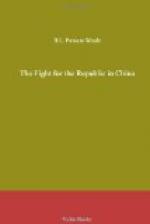Considering that China has claimed and exercised sovereign rights over Tibet, commanded the Tibetan army, supervised Tibetan internal administration, and confirmed the appointments of Tibetan officials, high and low, secular and even ecclesiastical, such expectations are modest enough, surely. At the present moment, with communication via India closed, with no official representative or agent present, with relations unsettled and unregulated, the position of China vis-a-vis Tibet is far from satisfactory and altogether anomalous, while as between China and Great Britain there is always this important question outstanding. An early settlement in a reciprocal spirit of give and take and giving reasonable satisfaction to the legitimate aspirations and claims of all parties is extremely desirable.
4 Degrees outer Mongolia
The world is more or less acquainted with the events in Urga in December, 1911, and the proclamation of independence of Outer Mongolia with Jetsun Dampa Hutukhtu as its ruler. By the Russo-Chinese Declaration of November 5, 1913, and the Tripartite Convention of Kiakhta of 1914 China has re-established her suzerainty over Outer Mongolia and obtained the acknowledgement that it forms a part of the Chinese territory. There remains the demarcation of boundary between Inner and Outer Mongolia which will take place shortly, and the outstanding question of the status of Tannu Uriankhai where Russia is lately reported to be subjecting the inhabitants to Russian jurisdiction and expelling Chinese traders.
The Tannu Uriankhai lands, according to the Imperial Institutes of the Tsing Dynasty, were under the control of the Tartar General of Uliasutai, the Sain Noin Aimak, the Jasaktu Khan Aimak and the Jetsun Dampa Hutkhta, and divided into forty-eight somons (tsoling). Geographically, according to the same authority, Tannu Uriankhai is bounded on the north by Russia, east by Tushetu Khan Aimak, west by the various aimks of Kobdo, and south by Jasaktu Khan Aimak. By a Joint Demarcation Commission in 1868 the Russo Chinese boundary in respect to Uriankhai was denmited and eight wooden boundary posts were erected to mark their respective frontiers.
In 1910, however, a Russian officer removed and burnt the boundary post at Chapuchi Yalodapa. The matter was taken up by the then Waiwupu with the Russian Minister. He replied to the effect that the limits of Uriankhai were an unsettled question and the Russian Government would not entertain the Chinese idea of taking independent steps to remark the boundary or to replace the post and expressed dissatisfaction with the work of the Joint Demarcation Commission of 1868, a dissatisfaction which would seem to be somewhat tardily expressed, to say the least. The case was temporarily dropped on account of the secession of Uliasutai from China in the following year.




